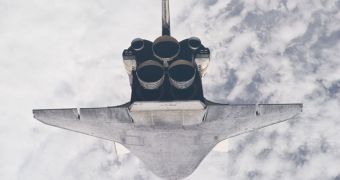Today, May 24, the six members of Atlantis' crew conducted the last heat shield inspection of the STS-132 mission, the shuttle's last planned one. The procedure lasted several hours, and saw the astronauts using the 50-foot-long, sensor-laden inspection pole to peer at the delicate ceramic tiles that make up the orbiter's vital heat shield. The procedure is now standard practice, after neglect and bad luck saw to the destruction of space shuttle Columbia upon atmospheric reentry, back in 2003.
Technically speaking, this was supposed to be the third overall heat shield inspection for Atlantis, but a glitch registered as the orbiter was chasing the International Space Station (ISS) in orbit on May 15 prevented the crew from carrying out the task. However, when they approached the orbital outpost, the crew made Atlantis do a back-flip maneuver, so that colleagues aboard the ISS could snap photos of the spacecraft's underbelly and wings. The data were sent back to Mission Control for detailed analysis, and preliminary results look very promising, NASA experts say. The information gathered from today's inspection will also be sent back to Earth, for final verification, Space reports.
“I fully expect things will look good and we'll be ready for landing on Wednesday,” explained on Sunday Brian Lunney, who is the NASA mission operations representative. The first window of opportunity for landing opens up Wednesday, May 26, at around 8:48 am EDT (1248 GMT). If the weather permits, then the orbiter will land its 32nd mission at the Kennedy Space Center (KSC) in Cape Canaveral, Florida. However, other options include the Edwards Air Force Base (EAFB), in the Mojave Desert, California, if all attempts to land in Florida fail. NASA officials usually prefer not to make the shuttles land in California, due to the high price tag associated to flying them back home.
“We've convinced ourselves, as a team, through all of the launch imagery that we've recovered via the solid rocket boosters recently, as well as the standard launch imagery, the wing leading-edge sensors, the [modified] flight day two inspection that we got via the digital camera on the orbiter boom sensor system, the rendezvous pitch maneuver images and then images obtained during the first spacewalk that Atlantis and its tile are ready to go and we just need to do the standard orbital debris inspection,” added Mike Sarafin, who is the lead shuttle flight director. Atlantis is returning from a 7-day stay on the ISS, where its crew helped install new solar batteries, spare parts, and the new MRM-1 Rassvet module.

 14 DAY TRIAL //
14 DAY TRIAL //